mobile View, to the German Version tap the flag


- also: Xinjiang
- separatist region in Western China
- 1949 occupation by China
- own names:
– Uyghur: Uyghurstan or Dsungarai
– Chinese: Xinjiang Uygur Zizhiqu
• Flag
• Historical Flags
• Meaning/Origin of the Flag
• Map
• Numbers and Facts
• History
• Origin of the Country's Name
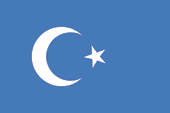
since 1949,
Flag of the Uyghur Independence Movement,
ratio = 2:3,
Source, by: UNPO






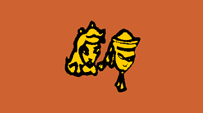
8th/9th century,
alleged flag of the Uyghur Empire,
Thanks to: Faruk Tezer,
Source by: anamurunsesi.com



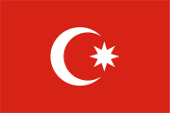
1864–1877,
Flag of Kashgaria
Source, by: World Statesmen



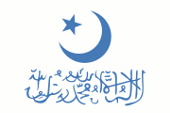
1933–1934,
Flag of the Islamic Republic of Eastern Turkestan,
Source, by:
Flags of the World,
World Statesmen



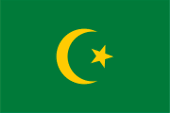
1944–1946,
Flag of the East Turkestan Republic,
Source, by:
Flags of the World,
World Statesmen



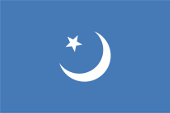
1944–1949,
National flag of the East Turkestan Republic,
Source, by:
Wikipedia (DE),
World Statesmen



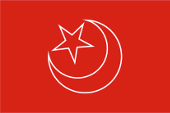
1943–1949,
National flag of the People's Republic (?),
Source, by:
Flags of the World,
Flaggen Enzyklopädie




In 1640, the Jungar Khanate of the Western Mongolian Oirats was established under Khungtaiji Batur, whose inhabitants were given the name Jungars (Dsungars). In 1758, the country was conquered by China. There were repeated many revolts of the Jungars against Chinese rule, the longest and most known to us was the revolt of Jakub Bek, who ruled an independent state of Kashgaria in western East Turkestan from 1865 to 1877. Ethnologically, in the 20th century, the Jungars had become the Uyghurs again, a return to an ancient Turkestan ethnic group that existed from the 8th to the 14th century. In context with the Chinese revolution of 1911 finished not only the monarchy, but the whole Chinese state decayed in a dissolution process. Political armed forces (Guomindang, Communists, Monarchists), national troops (Mandshu, Mongol, Uyghurs ...) and local warlords partitioned the country among themselves and fought a permanent civil war, temporary interrupted by the Japanese intervention (1937–1945). The Uyghurs – a Turk nation between Tibet, Mongolia, Kazakhstan and Kyrgyzstan became – quasi independent by the collapse of China. They established two-times an own state namely 1933 to 1934 the Islamic Republic of Eastern Turkestan and 1943 to 1949 the East Turkestan Republic. On this occasion was hoisted each time a blue (pale blue) flag with half-moon and star in white. Blue is the colour of the Tatar nations (Turk nations and Mongols) and half-moon and star stand for the Islam, the predominant religion. There are also reports of a green flag with crescent and star in gold between 1943 and 1949, perhaps representing a different political direction or a counter-government. The fact is that the Soviet Union intervened during this period and, by supporting East Turkestan, sought its incorporation into its territory, a fate already shared by all the Turkic peoples of Central Asia. It is possible that the project of a People's Republic of East Turkestan loyal to the Soviet Union dates back to this period, and that a few sources report on its red flag, a fact that would not have been untypical for the Soviet Union's actions in such cases. The Uighur state was finished im 1949 under the strikes of the Chinese People's Liberation Army. Thereafter counts the blue flag as flag of the Uighur nationalists which want to separate East Turkestan in an until today persistant armed underground struggle from China. In this way broke out 45 armed riotings in 15 different parts of East Turkestan in the year 1996. About the historic flag of the Empire of the Uyghurs is nothing known. The saffron coloured bunting could be a hint to the buddhism, the original religion of the Uyghurs, to which the Yughurs in central China belong until today.
Source:
Flags of the World,
1) Wikipedia (DE),
2) Wikipedia (DE),
Volker Preuß

Location:
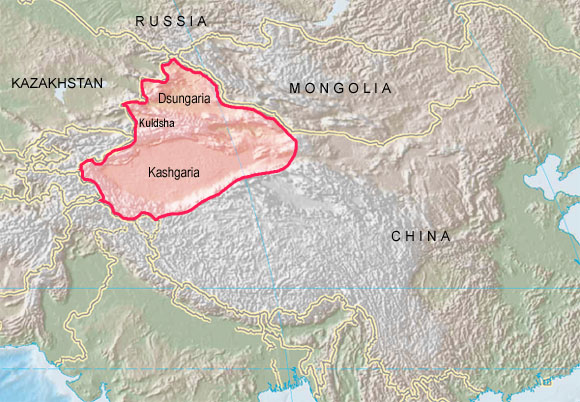
Source: Freeware, University of Texas Libraries, modyfied by: Volker Preuß

Area: 633.328 square miles
Inhabitants: 25.852.345 (2020), thereof 45% Uyghurs, 41% Chinese (Han), 12% other Turk nations and Mongols
Religions: 58% Muslim, 30% Daoists, Confucianists, Buddhists, 1% Christian
Density of Population: 41 inh./sq.mi.
Capital: Ürümqi, 4.054.369 inh. (2020)
official Language: Chinese
other Languages: Uyghur, Kazakh, Kyrgyz
Currency: Chinese currency
Time Zone: GMT + 8 h (Chinese Central Time)
Source: Wikipedia (DE)

3rd century B.C. · the today's East Turkestan is inhabited by the "Xiongnu" (ethnical unclear)
5th century B.C. · conquest of the today's East Turkestan by the White Huns (Hephthalites)
6th–8th century · the Eastern Turks (Old Uyghurs) settle in the today's Mongolia, partial migration to the today's East Turkestan, there rule of regional dynasties out of the nations of the Tibetans, Uyghurs, Kyrgyz, Mongol and Dsungars
745–840 · Eastern Turk Empire in today's Mongolia
840 · the Eastern Turk Empire of the Uyghurs becomes destroyed by the Kyrgyz, migration of the Uyghurs to East Turkestan (Xinjiang), mix with the there living Tokhar and Iranian population, nascence of the today’s Turk Nation of the Uyghurs
9th–13th cent. · islamic Empire of the Kara-Khanids in the west of East Turkestan, Empire of the Uyghurs in the east of East Turkestan, gradual expansion of islam over whole East Turkestan
1219 · conquest by the Mongols under Dshingis Khan
1227 · death of Dshingis Khan, his empire became partitioned under his four sons. Tshutshi got Western Sibiria; Uegedei got the today’s China, Korea and the today’s Mongolia and Manchuria and he became nominated to successor and Grand Khan; Chagatai got Eastern Turkestan, the today’s Tajikistan, Kyrgyzstan and Uzbekistan; Subutai got the today’s Afghanistan and Turkmenistan.
15th cent. · Staate of Mogolistan
17th cent. · Staates of Kashgaria and Dsungaria
1758 · conquest of Dsungaria by China (northern East Turkestan)
1760 · conquest of Kashgaria by China (southern East Turkestan)
19th cent. · increasing Russian influence, Islamic riotings
1871 · China cedes the Ghulja Region (Yining) for 10 years to Russia
10th of October 1911 · overthrow of the monarchy in China, civila war and agitations, East Turkestan (Uyghuristan) becomes de facto independent
1916–1928 · civil war in China (monarchists against bourgeois Guomindang and local groups)
1928–1935 · civil war in China (communists against Guomindang and local groups)
1933–1934 · Islamic Republic of Eastern Turkestan
1937–1945 · war in China (communists and Guomindang against Japan)
1944–1949 · Republic of East Turkestan
1945–1949 · civil war in China (communists against Guomindang and local groups)
1st of October 1949 · proclamation of the People’s Republic of China
October 1949 · invasion of the Chinese People’s Liberation Army in East Turkestan, annexation to China, in the afteryears potent Chinese settlement
1955 · East Turkestan becomes "Uighur Autonomous Region"
1964 · first tests of nuclear weapons of the Chinese Army
Source:
Wikipedia (D),
Flags of the World,
World Statesmen

Turkestan (or Turkistan) is a central Asian countryside which ist settled by numerous Turk nations. Turkestan is divided by the Russian-Chinese rivalries in the past centuries in West Turkestan (Kyrgyzstan, Tajikistan and Uzbekistan) and East Turkestan (Chinese Turkestan). East Turkestan is the homeland of the Uyghurs – situated between Tibet, Mongolia, Kazakhstan und Kyrgyzstan. The denomination "Uyghurs" is indeed very old and refers to one Turk tribe, but was adoped as common designation for all Turk nations in East Turkestan at a Turk nations congress in the year 1921 in Tashkent. The word "Uighur" is related with the Turkish word "uygar" and means "civilized".
Source:
Die Völker der Erde, Volker Preuß


![]()











